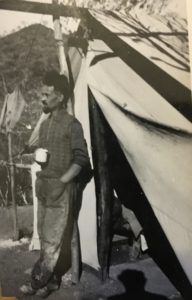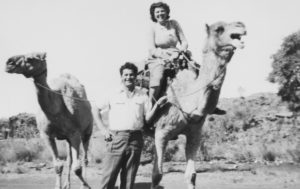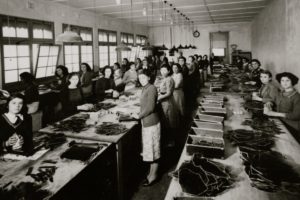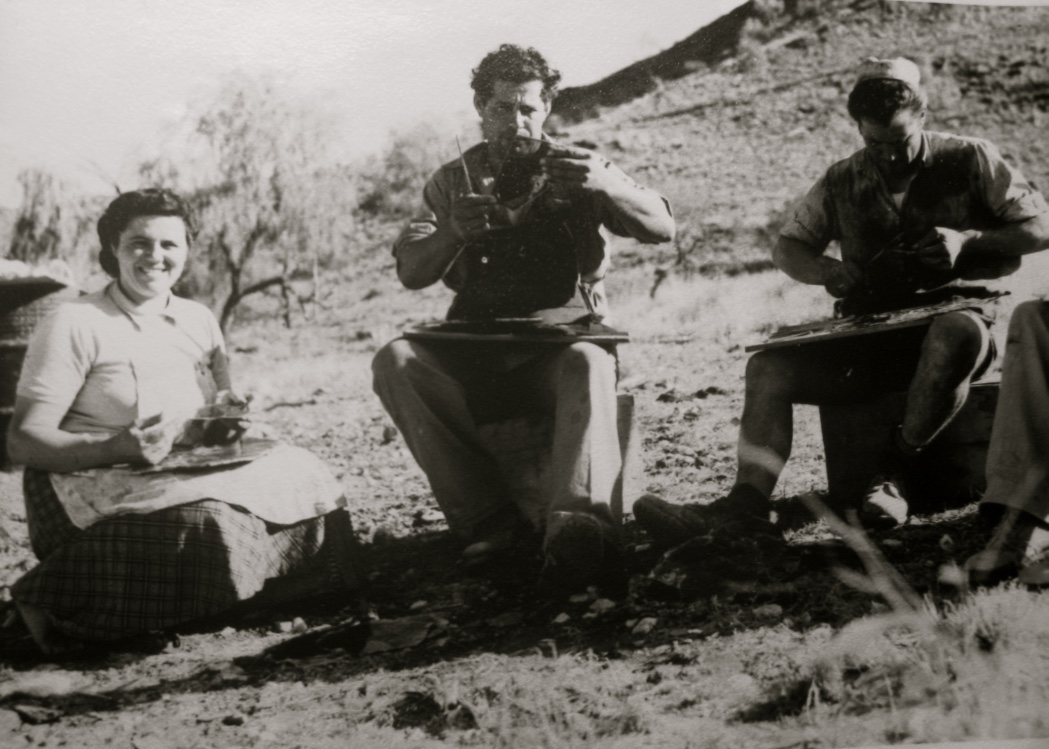Several Veneto men went to mine mica in the Northern Territory from the early 1930s. The mine was called ‘Spotted Tiger’. It was about 200 kilometres north east of Alice Springs and 1500 kilometres from Adelaide.
Mica was used for insulating electrical goods like irons and heaters. It was first mined in central Australia at the end of 19th Century and after the 1920s it was used in Australia and other countries. After it was mined, the mica was transported by camel to Alice Springs and sent to Adelaide for processing at a factory owned by the Brazzale family. During the Second World War mica was used in instruments in planes. The Allied Works Council employed men to develop the mica fields in the war years. Vittorio Marchioro worked for a period at Spotted Tiger.

Italians began arriving to work at the mines after World War 1. The Italians were willing to work in extreme conditions such as the desert and remote locations of ‘Spotted Tiger’ and ‘Last Chance’ mica mines.
Some of the veneti who worked on the mica mines before and during the Second World War included Angelo Piovesan, Attilio Piovesa, Gelindo, Angelo and Beppi Rossetto. Lena Moscheni nee Rossetto reported in her interview that her father, Gelindo Rossetto was one of eight people who bought shares in the Spotted Tiger mine. You can listen to Lena’s interview on the website.

A new wave of veneti worked at Spotted Tiger after the war including Augusto Mattiazzo and Leandro Bortoletto. Some courageous women, like Bruna Rossetto nee Battaglia, took their children and joined their husbands there. Armida Mattiazzo nee Biasetto was newly married and lived there with her husband and two children were born while she was there. Maria Bortoletto also lived there. (You can listen to Bruna and Armida talk about their experience in interviews on this website)

At Brazzale’s mica factory several young women of the Veneto market gardener community were employed in the 1940s and 1950s. Bruna Rossetto nee Battaglia worked there from the time she arrived with her mother and sisters in 1938. Italia Tonellato nee Bergamin was another employee. Sisters, Milva, Bruna, Roma and Christine Zampin worked at Brazzale’s after they left school. Each of these women have been interviewed for the project and you can listen to their interviews and read their transcripts on the website.

The mica mines closed down at the end of the 1950s when the need for mica decreased.
Madeleine Regan
1 September 2019
La miniera di mica e veneti
Certi veneti cominciarono lavorare nelle miniere di mica nel Northern Territory dagli anni ’20. La miniera si chiamava ‘Spotted Tiger’. La miniera era circa 200 chilometri da nord-est di Alice Springs e circa 1500 chilometri da Adelaide.
La mica era usata per isolare materiale elettrico come le stufe, i caloriferi o i ferri da stiro. Durante la seconda guerra mondiale mica era usata in istrumenti elettronici in aerei.

È stato estratto nella Australia Centrale e negli anni 1920 è stato usato in Australia e altri posti. Dopo che la mica è stata minata, venne trasportata ad Alice Springs con i camelli. È manifatturata in una fabbrica di Adelaide.
Gli italiani cominciarono ad arrivare per lavorare nelle miniere dopo la prima guerra mondiale. Erano disposti a lavorare in condizioni estreme come il deserto e nelle zone isolate come le miniere, ‘Spotted Tiger’ e ‘Last Chance’. Alcuni uomini conessi al progetto lavoravano nella miniera prima e durante la seconda guerra mondiale includono Gelindo Rossetto, Angelo Piovesan, Attilio Piovesan e Galliano Tormena. Il governo Australiano ha migliorato l’infrastrattura per agevolare il lavorati il loro posto di lavoro. Vittorio Marchioro lavorò nella miniera per il governo Australiano per un periodo durante la guerra.
Lena Moscheni nata Rossetto ha riportato nella sua intervista che suo padre Gelindo Rossetto era uno delle otto persone che comprò azioni nella miniera, ‘Spotted Tiger’.

Dopo la guerra una nuova ondata di italiani emigrò in Australia e andarono a vivere e lavorare nella miniera includendo Beppi e Angelo Rossetto, Augusto Mattiazzo e Leandro Bortoletto. Certe donne coraggiose come Bruna Rossetto nata Battaglia presero i loro bambini e raggiunsero il loro mariti per due anni.

Armida Mattiazzo di recente era arrivata dall’Italia e si era appena sposata quando andò a raggiungere suo marito Augusto che era già lì. Rimase lì per circa sei anni e i suoi primi bambini erano nati mentre viveva in una tenda. Maria Bortoletto anche visse con suo marito, Leandro. Le donne cucinavano, pulivano e abitavano in tende. Potete ascoltare Bruna e Armida raccontare la loro esperienza nelle interviste in questo sito web.

Ad Adelaide la mica era processata nella fabbrica che apparteneva a una famiglia Italiana si chiamava Brazzale. La fabbrica era situata nella parte occidentale della città dove vivevano gli italiani. Tante donne italiane lavoravano da Brazzale. Alcune donne che ho intervistato per il progetto lavoravano nella fabbrica. Due donne della generazione 1.5 (arrivarano come adolescente) Bruna Rossetto e Italia Tonellato nata Bergamin lavorarono a Brazzale. Sorelle, Milva, Bruna, Roma e Christine Zampin lavorarono anche a Brazzale. Puoi trovare le interviste con queste donne sul sito web.
La miniera di mica ha chiuse battenti alla fine dell 1950 quando la richiesta di mica si è ridotta.
Madeleine Regan
1 settembre 2019

Giovanni Rebuli
07:43 (2 ore fa)
a venetomarketgardeners1927
Hi Madeleine….brings back memories. When dad arrived in Adelaide his first job was mica mining up in central Australia for abt 1 year and mum’s first job was at the Brazzale mica processing plant and I have clear images of small mica sheets that mum showed me.
See ya
Johnny
Giovanni Rebuli
—————————————-
08:21 (1 ora fa)
a venetomarketgardeners1927
……Just quickly read an article on mica mines in Hart Ranges. Apparently the majority of miners were Italian and their was no salary. Instead the miners were “shareholders” and any money made was through sales of the mica.
Mining mica pettered out after 1950…was not profitable due to lack of suitable infrastructure and the position of the mines was in desolate “inhospitable” locations. Cheaper mica mining in India did the rest.
Johnny